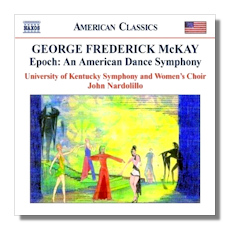
The Internet's Premier Classical Music Source
Related Links
- McKay Reviews
- Latest Reviews
- More Reviews
-
By Composer
-
Collections
DVD & Blu-ray
Books
Concert Reviews
Articles/Interviews
Software
Audio
Search Amazon
Recommended Links
Site News
 CD Review
CD Review
George Frederick McKay

Epoch
An American Dance Symphony
University of Kentucky Women's Choir
University of Kentucky Symphony/John Nardolillo
Naxos 8.559330 DDD 62:52
A while back, I reviewed another McKay disc from Naxos (8.559225) which contained his Violin Concerto, Sinfonietta #4, Suite on Sixteenth Century Hymn Tunes, and Song Over the Great Plains. I was enthusiastic about it, calling it "lively and memorable," so I decided to give this one a listen.
McKay (1899-1970) was born and spent most of his life in the state of Washington, although he was educated at the Eastman School of Music in Rochester, New York. He studied with Christian Sinding (Rustle of Spring) and Selim Palmgren, and later, his pupils included John Cage and William Bolcom.
Epoch is an ambitious yet impressionistic attempt to portray American history and development through the lenses of four poets: Edgar Allan Poe, Sidney Lanier, Walt Whitman, and Carl Sandburg. It is particularly ambitious because it was more than simply an hour-long orchestral score with voices; as the subtitle indicates, there was dancing as well, and sets, and costumes. Apparently McKay and fellow faculty members at the University of Washington went into a sort of wild creative tear as the Great Depression was drawing to a close. The results were lauded in the local press at the time of the 1935 première. There appear to have been at least two more performances in 1936, but I suspect that the score remained otherwise untouched until the University of Kentucky Symphony Orchestra took it on. This, of course, is the dance symphony's first recording.
The booklet includes an extensive synopsis of the four movements, prepared by McKay and his collaborators for the première. It is best to follow along, because frankly, I don't think the music stands up all that well by itself, with the exception of the lovely second movement, titled "Pastoral," and inspired by Lanier. (According to the synopsis, "The second movement … includes all that is sane, normal and peaceful in nature … summing up the romance of southern hillsides, streams and bays.") This is where the women's chorus is used, and its wordless vocalizing is evocative. Poe's troubled spirit lies behind the first movement ("Symbolic Portrait"), which also is effective, but a little disjointed musically. The third movement, "Westward!," is inspired by Whitman, "a lonely figure, a champion of the common man yet never accepted by him as a friend." (Ha!) McKay's portrait of American expansion uses Coplandesque tropes, even down to quoting cowboy songs, but it doesn't add up to a convincing whole. I gather that the fourth movement ("Machine Age Blues") was the sensation of the original production. "Sandburg and the 20th century find machinery fully developed with man as its slave, not its master," the program tells us. (And the internet hadn't even been invented yet!) This premise seems to call for something really demonic, or at least as spicy as Bartók and Prokofieff, for example, but McKay's music doesn't rise to the occasion, and at the movement's climax we get some tepid orchestral jazz; it's more insipid than insane. As I suggested above, perhaps this music made a greater effect in the context of the original, but heard on its own, it's little more than a curiosity, particularly in the second half of the symphony.
The University of Kentucky's School of Music is shown to good advantage by this recording. Those lucky to live close to one of the major music schools know that student orchestras can be just as good as professional orchestras, and in some ways (enthusiasm, open-mindedness, etc.) even better. One never feels that the score's potential is unrealized by this orchestra, who literally gives it the "old college try" on this CD. The women's chorus sings with polish and has youth on its side, and that's not a negligible factor in the second movement. The engineering is straightforward and complementary.
Copyright © 2009, Raymond Tuttle





















